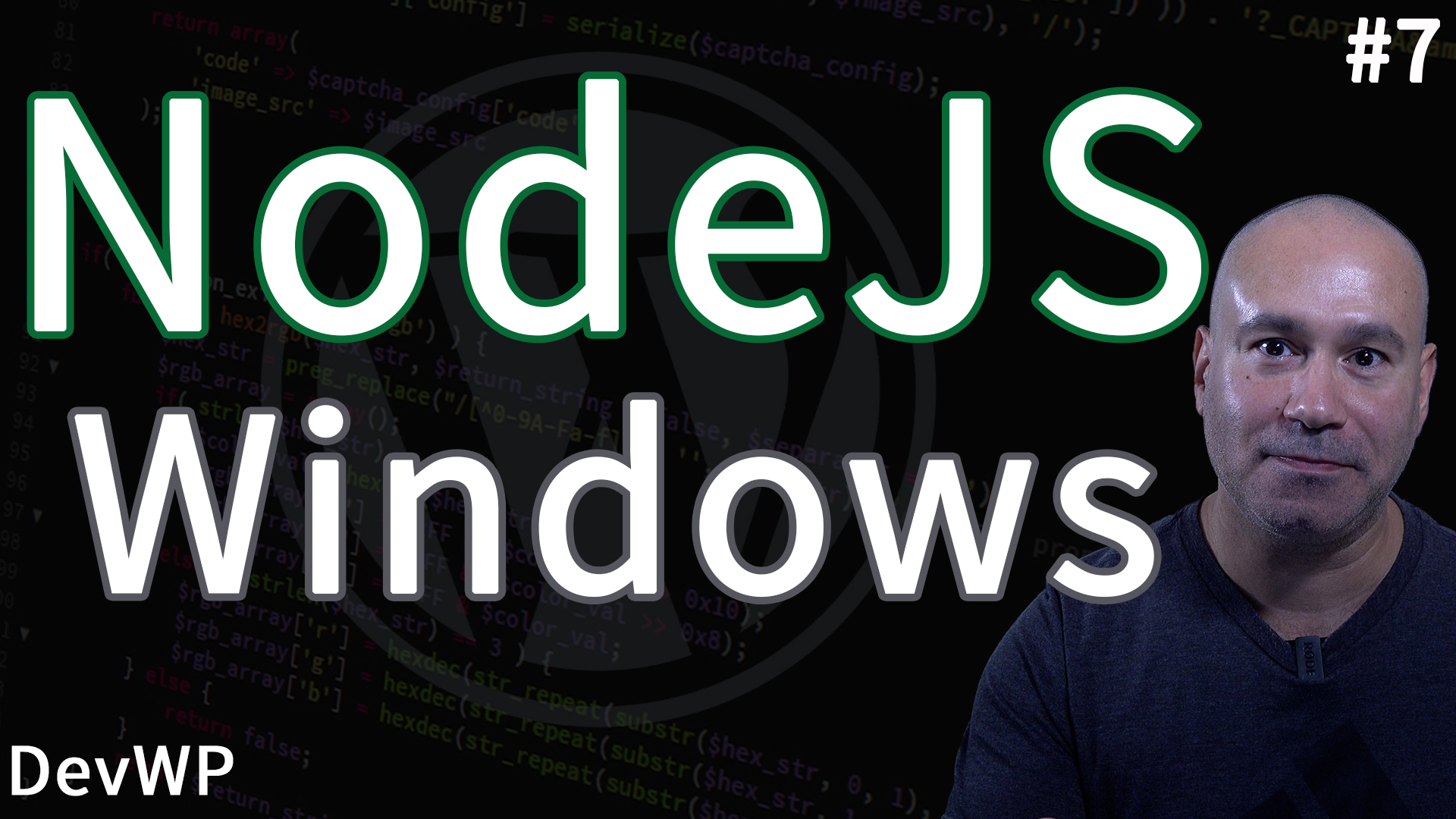What is Node.js?
Node.js is a powerful open-source runtime environment that enables you to run JavaScript code on the server-side. Leveraging the V8 JavaScript engine developed by Google, Node.js provides an event-driven, non-blocking I/O model, making it lightweight and efficient for building scalable network applications.
I use Node.js in all of my main projects because it helps me to automate a significant amount of my workflow. While developing my Custom WordPress Hybrid Theme DevWP, I demonstrate how to properly setup and use Node.js and explain the benefits of automation.
- Node.JS Official Site
- Node.JS Install on Windows Video
- Node.JS Install on macOS Video
- Node.JS Package JSON file Code Video
Installing nvm on macOS
To manage multiple versions of Node.js easily, you can use nvm (Node Version Manager).
Steps to Install nvm
- Install nvm: Visit the NVM for macOS page for the latest instructions and version. Run the following command in your terminal:
curl -o- https://raw.githubusercontent.com/nvm-sh/nvm/v0.39.7/install.sh | bash - Restart Terminal: Close and reopen your terminal.
- Verify Installation: Check your nvm version with:
nvm -v
Using nvm to Manage Node.js Versions
- Set Default Node Version:
nvm alias default node - Check Node.js Version:
node -v - Install Node.js:
nvm install node - Switch Node.js Versions:
nvm install 20.14.0 nvm install --ltsMake sure to change the version number to the latest LTS as noted on from the Node.js website.
- View Local and Remote Versions:
nvm ls nvm ls-remote - Update Node to Latest LTS:
nvm install 'lts/*' --reinstall-packages-from=current
Node.js on Windows
For Windows users, download Node.js directly from the Node.js Official Site. Follow the installation instructions provided.
NPM: Node Package Manager
NPM (Node Package Manager) is a vital tool for managing dependencies in your projects. It streamlines your workflow by automating tasks and managing packages efficiently.
Installing NPM Packages
To install a package, use the following command:
npm install package-to-install --save-devOr the shorthand version:
npm i package-to-install -DKey Packages for a Productive Workflow
- Autoprefixer: Automatically adds vendor prefixes to CSS rules.
npm i autoprefixer -D
npm install bootstrap --save-devnpm install chokidar-cli --save-devnpm i concurrently -Dnpm install dir-archiver --save-devnpm i @fortawesome/fontawesome-free -Dnpm i postcss-cli -Dnpm i sass -Dnpm i terser -DInstalling All Packages at Once
To install all the necessary packages with one command, run:
npm install @fortawesome/fontawesome-free autoprefixer bootstrap chokidar-cli concurrently dir-archiver postcss-cli sass terser --save-devFull `package.json` File
Create a package.json file in the root of your theme and paste the following code. Then, run npm install to install all dependencies:
{
"name": "devwp",
"version": "1.4.6",
"description": "DevWP WordPress Development Training Theme",
"author": "PixemWeb",
"license": "GPL-3.0",
"devDependencies": {
"@fortawesome/fontawesome-free": "^6.5.
2",
"autoprefixer": "^10.4.19",
"bootstrap": "^5.3.3",
"chokidar-cli": "^3.0.0",
"concurrently": "^8.2.2",
"dir-archiver": "^2.1.0",
"postcss-cli": "^11.0.0",
"sass": "^1.77.0",
"terser": "^5.31.0"
},
"scripts": {
"copyfonts": "cp node_modules/@fortawesome/fontawesome-free/webfonts/*.{ttf,woff2} ./webfonts/",
"copyBS5": "cp -r node_modules/bootstrap/scss ./src/sass/bootstrap",
"buildcss": "sass --style expanded --source-map src/sass/style.scss dist/css/style.css && sass --style expanded --source-map src/sass/editor-styles.scss dist/css/editor-styles.css && sass --style compressed --source-map src/sass/style.scss ./style.css && sass --style compressed --source-map src/sass/editor-styles.scss dist/css/editor-styles.min.css && postcss style.css --use autoprefixer -o style.css --map && postcss dist/css/editor-styles.min.css --use autoprefixer -o dist/css/editor-styles.min.css --map",
"buildjs": "node concatmin.js",
"build": "npm run buildcss && npm run buildjs",
"watchcss": "chokidar \"src/sass/**/*.scss\" -c \"npm run buildcss\"",
"watchjs": "chokidar \"src/js/**/*.js\" -c \"npm run buildjs\"",
"watch": "concurrently \"npm run watchcss\" \"npm run watchjs\"",
"dev": "dir-archiver --src . --dest ../devwp-dev.zip --exclude .DS_Store .git composer.lock node_modules vendor package-lock.json .phpcs-cache .phpunit.result.cache",
"prod": "dir-archiver --src . --dest ../devwp-prod.zip --exclude .DS_Store .git composer.lock node_modules vendor package-lock.json .stylelintrc.json .gitattributes .github .gitignore composer.json package.json phpcs.xml.dist .editorconfig .phan .phpcs-cache concatmin.js phpmd.xml phpstan.neon.dist phpunit.xml psalm.xml stubs tests phpinsights.php .phpunit.result.cache devwp-vars-1.txt devwp-vars-2.txt"
}
}Running Scripts from `package.json`
The package.json file allows you to define custom scripts that can be run using the npm run command followed by the script name. These scripts can automate various tasks and streamline your development workflow and save us from developing carpal tunnel syndrome.
Here are the scripts defined in the provided package.json file:
- copyfonts: Copies font files from the
@fortawesome/fontawesome-freepackage to thewebfontsdirectory.npm run copyfonts - copyBS5: Copies the Bootstrap 5 Sass files from the
node_modules/bootstrap/scssdirectory to thesrc/sass/bootstrapdirectory.npm run copyBS5 - buildcss: Compiles Sass files, generates source maps, and runs PostCSS with Autoprefixer on the compiled CSS files.
npm run buildcss - buildjs: Runs the
concatmin.jsscript to concatenate and minify JavaScript files.npm run buildjs - build: Runs both the
buildcssandbuildjsscripts to build the project.npm run build - watchcss: Watches for changes in the Sass files located in the
src/sassdirectory and runs thebuildcssscript whenever a change is detected.npm run watchcss - watchjs: Watches for changes in the JavaScript files located in the
src/jsdirectory and runs thebuildjsscript whenever a change is detected.npm run watchjs - watch: Runs both the
watchcssandwatchjsscripts concurrently to watch for changes in both Sass and JavaScript files.npm run watch - dev: Creates a ZIP archive of the project files, excluding certain files and directories, for development purposes.
npm run dev - prod: Creates a ZIP archive of the project files, excluding certain files and directories, for production purposes.
npm run prod
To run any of these scripts, open your terminal, navigate to the project directory containing the package.json file, and use the npm run command followed by the script name. For example:
npm run buildThis command will execute the build script, which in turn runs the buildcss and buildjs scripts to compile Sass files, generate source maps, run PostCSS with Autoprefixer, and concatenate and minify JavaScript files.
Using these scripts can greatly simplify your development process by automating repetitive tasks and ensuring consistent builds across different environments.
Remember to run npm install before running any of these scripts to ensure that all the required dependencies are installed in your project.
By following this guide, you can set up Node.js and a suite of helpful NPM packages to streamline your development workflow. This setup ensures that you have all the necessary tools to build, watch, and deploy your WordPress themes efficiently.
